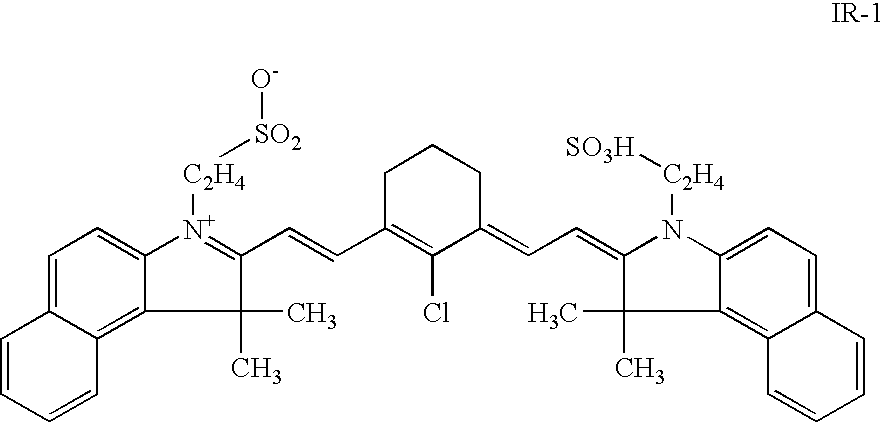Method for making a lithographic printing plate
- Summary
- Abstract
- Description
- Claims
- Application Information
AI Technical Summary
Benefits of technology
Problems solved by technology
Method used
Image
Examples
example 1
[0059] After imaging, the plate precursor 1 was processed in an Agfa VA88 processor, operating at a speed of 1 m / min and at 23° C., using a carbonate buffer with / without a surfactant (Table 2).
[0060] After development, the plate was gummed with RC795 (trademark of Agfa).
[0061] The occurrence of stain on the obtained printing plates was determined (Dmin).
TABLE 2developer solution comprising a carbonate buffer andLibrateric AA30DeveloperpHDmin42 g / l NaHCO3 + NaOH to pH:10.870.35Comparative example8 ml / l Librateric AA30 (1) + 42 g / l11.00.09NaHCO3 + NaOH to pH:Invention example
(1) surfactant commercially available from Libra Chemicals Limited, Manchester UK.
[0062] The data of Table 2 show that the addition of Librateric AA30 to the developer solution comprising a carbonate buffer improves the Dmin value. A Dmin value<0.1 is defined as no stain.
example 2
[0063] After imaging, the printing plate precursor 1 was processed in an Agfa VA88 processor, operating at a speed of 1 m / min and at 23° C., with a developer solution comprising a phosphate buffer with / without a surfactant Genapol C200 or Librateric AA30 (Table 3).
[0064] After development, the plates were gummed with RC795 (trademark from Agfa).
TABLE 3developer solution comprising a phosphate buffer andGenapol C200 or Librateric AA30Surface TensionDeveloperPHDminmN / m4.4 g / l NaH2PO4 + NaOH to pH:10.970.1172.3Comparative example33 ml / l Genapol C200 (1) + 4.4 g / l10.870.06341.2NaH2PO4 + NaOH to pH:Invention example6.8 ml / l Librateric AA30 (2) + 4.4 g / l10.80.05439.6NaH2PO4 + NaOH to pH:Invention example
(1) surfactant commercially available from Clariant GmbH, Frankfurt am Main Germany;
(2) surfactant commercially available from Libra Chemicals Limited, Manchester UK.
[0065] The data of Table 3 show that the addition of Genapol C200 or the addition of Librateric AA30 to the developer s...
example 3
[0066] After imaging, the printing plate precursor 1 was processed in an Agfa VA88 processor, operating at a speed of 1 m / min and at 23° C., with a developer solution comprising a silicate buffer with / without a surfactant Genapol C200 or Librateric AA30 (Table 4).
[0067] After development, the plates were gummed with RC795 (trademark from Agfa).
TABLE 4developer solution comprising a silicate buffer and GenapolC200 or Librateric AA30Surface TensionDeveloperpH DminmN / m1 ml / l10.80.11972potassiummetasilicateComparative example1 ml / l10.740.07241.4potassiummetasilicate + 33 ml / lGenapol C200 (1)Invention example1 ml / l10.80.07637.8potassiummetasilicate + 6.8 ml / lLibrateric AA30 (2)Invention example
(1) surfactant commercially available from Clariant GmbH, Frankfurt am Main Germany;
(2) surfactant commercially available from Libra Chemicals Limited, Manchester UK.
[0068] The data of Table 4 show that the addition of Genapol C200 or the addition of Librateric AA30 to the developer solution c...
PUM
 Login to View More
Login to View More Abstract
Description
Claims
Application Information
 Login to View More
Login to View More - R&D
- Intellectual Property
- Life Sciences
- Materials
- Tech Scout
- Unparalleled Data Quality
- Higher Quality Content
- 60% Fewer Hallucinations
Browse by: Latest US Patents, China's latest patents, Technical Efficacy Thesaurus, Application Domain, Technology Topic, Popular Technical Reports.
© 2025 PatSnap. All rights reserved.Legal|Privacy policy|Modern Slavery Act Transparency Statement|Sitemap|About US| Contact US: help@patsnap.com

